How to play Puerto Rico Board Game Rules if you hate rulebooks
I hate rulebooks! This condensed How to Play Puerto Rico board game rules help players get the essential instructions without having to trawl rulebooks.
The Puerto Rico overview page introduces you to the game through a summary of the gameplay and videos shared by other gamer.
What is the goal?
Puerto Rico Board Game is played over several rounds. In each round, each of you will choose one of seven different roles and, in clockwise order, take the action associated with that role
For example:
- As the settler, you can place new plantations
- Change to the role of the craftsman and start producing goods.
- Become the trader and you can sell those goods to the trading house or
- choose the captain, and ship them to the old world.
- With the money earned, build buildings in the city by choosing the role of the builder, and so on.
The player who best manages the changing roles with their associated actions and special abilities will achieve riches and the highest respect and win the game.
Game setup
- Place the game board in the middle of the table
- Place all the buildings on their assigned spaces on the game board (see below).
- Sort the doubloons by value and place them on the bank on the game board (see below).
Each player will get:
- 1 player board
- money:
- with 3 players: 2 doubloons
- with 4 players: 3 doubloons
- with 5 players: 4 doubloons
- Players store their doubloons on the windrose on their player boards, so that all players can see how much money each player has
- 1 plantation tile. The players choose a starting player. The Starting player takes the governor card and a blue indigo tile (which is placed face-up on any of the 12 spaces on the player\’s island).
- The other players take the following in clockwise order:
- with 3 players: 2nd player: indigo / 3rd player: corn
- with 4 players: 2nd player: indigo / 3rd and 4th players: corn
- with 5 players: 2nd and 3rd players: indigo / 4th and 5th players: corn
Gameplay
Puerto Rico Board Game is played over several rounds (about 15).
- Each round is played in the same way.
- The player with the governor card begins and
- takes one of the role cards, places it face-up next to their player board, and takes the role card’s action
- the player to the left takes the action allowed by that role card, and this moves clockwise around the table until every player has taken this action once
- Next, the left player next to the governor takes their turn:
- takes one of the remaining role cards, places it face-up next to his player board, and takes the role cards’s action
- the player’s left neighbour takes the action allowed by that role card, and this moves clockwise around the table until every player has taken this action once
- Then, his left neighbour takes a role card, and so on until all players have taken a role card and all players taken the actions allowed by the role cards taken.
- Next, place one doubloon on each of the three unchosen role cards during the round
- Then, place the used role cards back on the table next to the unused cards.
- The left neighbour of the governor card takes the governor card, becoming the governor for the next round. He begins the round and the game continues as before.
The Role Cards
Each role grants:
- the player who takes the card a special privilege, and
- a specific action that can be taken by each player, in clockwise order, starting with the player who took the role (exception: prospector).
Basic rules for all role cards:
- If a card has one or more doubloons on it, the player who takes the card gets the doubloons in addition to the privilege and action
- The role card\’s action is taken first by the player who took the card, followed by the others in clockwise order.
- A player must always take a role card when it is his turn to do so, but he the action or privilege of the card is optional
- The other players get their turns at the card\’s actioln
- The action of a role card is optional (exception: captain). A player may choose not to or be unable to use the action on his turn.
- A role card remains in front of the player who took it until the end of the round. It may not be taken by another player in the round.
The Settler

If you choose this role, you may:
- take either a quarry tile as your privilege or one of the face-up plantation tiles and place it on any empty island space on his player board
- Afterwards, other players, may take one of the face-up plantation tiles (not a quarry tile! -exception: construction hut) and place it on any empty island space on their player board.
- put the untaken plantation tiles face-up on a plantation discard stack and draw new plantation cards from the face-down stacks, placing them face-up next to the quarry stack. You draw one more than the number of players.
Things to note:
- Remember the special functions of the hacienda, construction hut, and hospice.
- If there are not enough plantation tiles left in the face-down stacks, you first draw what\’s left and place those.
- Shuffle the discarded plantation tiles and creates a new face-down stack, and fill the face-up row.
- If there are insufficient tiles to refill the face-up row, players in following rounds may have to do without.
- Once all 12 island spaces on your player board are filled, you may not place plantation or quarry tiles in future settler phases.
- If there are no more quarry tiles in the quarry tile stack, the settler may not use his privilege and construction hut owners may not use that special function.
The Mayor

- The tiles (plantation, quarry, or building) have 1 to 3 circles. If you choose this roe, you may place one colonist on each circle on the tiles on your board.
- If there is at least one colonist on a tile, it is considered occupied. Only occupied tiles may use their functions; unoccupied tiles never function!
- The player who selects this role may first take one colonist from the colonist supply (not from the colonist ship!) as his privilege.
- Next, the players take the colonists from the colonist ship one at a time, starting with the mayor.
- The players continue to take one colonist at a time, in clockwise order, until none remain on the colonist ship.
- A player may place his new colonist(s), together with all the colonists he acquired from earlier rounds, on any empty circles on the tiles on his board.
- If a player cannot place all his colonists, he may “store” them on San Juan city on his board.
- The colonists remain there until a later mayor phase when they may be placed on empty tile circles
- As his last duty, the mayor puts new colonists on the colonist ship to be used in the next mayor phase.
- For each empty circle on the buildings on the player boards of all players, the mayor takes one colonist from the colonist supply and places it on the colonist ship. However, as a minimum, the mayor should always place at least as many colonists as there are players in the game.
Things to Note:
- Usually, everyone place/move their colonists at the same time. If players feel that their placement decisions may depend on other’s placements, the players should follow the following order: first, the mayor and, then, the others in clockwise order from the mayor.
- If a mayor forgets to place new colonists on the ship, place the minimum (number of players) on the colonist ship.
- When the colonist supply runs out, the mayor may not use his privilege and, of course, he does not refill the colonist ship.
- You cannot place colonists in San Juan if there are empty circles available on your board
- All empty circles must be filled, if possible. Colonists may not be placed on the circles other than in the mayor phase.
The Builder
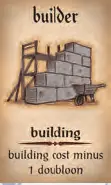
If you choose this role, you may:
- immediately build one building for one doubloon less than the normal cost as your privilege. You pay the money to the bank, take the building from the supply, and places it
on any empty space in the city on your board.
When placing a large building, you need two adjacent empty spaces. T
The other players, in clockwise order from the builder, may, in the same way, each builds one building (at normal cost).
Note: No player may build more than one building per round.
Quarry
- Each occupied quarry that you own reduces the cost for building a building by 1 doubloon
- The limit for such reductions is shown on the game board:
- players building buildings in the first column can reduce their cost by at most 1 doubloon (1 occupied quarry),
- in the second column by at most 2 doubloons (2 occupied quarries),
- in the third column by at most 3 doubloons (3 occupied quarries), and
- in the fourth column by at most 4 doubloons (4 occupied quarries).
- The mayor’s privilege reduction is in addition to the quarry reduction, but the cost of a building may not be reduced below 0 doubloons.
- A player with 3 occupied quarries pays the following costs:
- construction hut: 1 doubloon;
- office: 3 doubloons;
- harbor: 5 doubloons;
- city hall: 7 doubloons.
The Craftsman
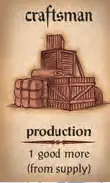
If you choose this role, you may:
- takes goods from the supply according to your production ability and place them on the windrose on your board.
Next, the other players take goods from the supply according to their abilities, in clockwise order from the craftsman.
As his last duty, the craftsman takes one additional good (of those he can produce) from the supply as his privilege.
Things to note:
- Remember the special function of the factory.
- If the kind of goods you produce is exhausted in the supply, you go without.
- If the craftsman does not produce goods, he does not get an extra good (privilege).
The Trader

If you choose this role, you:
- immediately sell one good to the trading house
- take from the bank the price associated with the sold good (0 – 4 doubloons) plus 1 doubloon as your privilege.
Then, in clockwise order from the trader, each other player may sell one good to the trading house for the price shown as long as the trading house has room.
The trader phase ends when all players have had one turn to sell or when the trading house is full.
When selling, use the following rules:
- The trading house has room for 4 goods.
- When it is full, no other players may sell goods in this trading phase.
- The trading house buys only different kinds of goods (exception: office).
As the last duty, the trader empties the trading house if it is full, placing them in their separate supply piles.
If there are fewer than 4 goods in the trading house:
- goods remain there
- It will be more difficult to sell goods in the next trader phase, because of the kinds of goods already there and the fewer number of spaces available.
Things to note:
- Remember the special functions of the small and large markets and the office.
- If the trader does not sell, he does not collect the extra doubloon (privilege).
- A player may sell corn to the trading house even though he earns no money for doing so.
The Captain
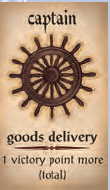
If you choose this role, you:
- are in charge of shipping goods to the old world and are the first to load goods on the cargo ships
- Then, the other players follow, in clockwise order from the captain.
Note:
- in the captain phase, each player may get several turns to load goods
- When it is a player’s turn to load goods, he must load if he can. However, a player may load goods of only one kind on a turn.
- The captain phase continues, clockwise around the table, as long as at least one player has goods he can load.
Loading/shipping rules
- Each cargo ship will carry goods of only one kind.
- You may not load goods on a cargo ship if goods of that same kind are on one of the other two cargo ships
- Players may not load goods on a full ship.
- You must load goods if you can. However, you may only load one kind of goods.
- When you load goods of a kind, you must load as many of that kind. You cannot hold back goods when there is space on a ship carrying the kind of goods you have
- If you have the kind of goods that can be loaded on several empty ships, you must choose the ship where you can load the most goods.
- If a player you have several kinds of goods that you can load, you may choose freely, which goods to load. You need not choose the goods that would allow you to load the most barrels.
Victory points
- For each good (each barrel, not each kind of good) you load, you earns one victory point (1 VP) or 1 victory point chip.
- When loading goods onto the cargo ships, all kinds of goods have the same value: 1 VP per barrel loaded!
- The goods values used in the trader phase are not used here.
- When loading the first kind of goods, the captain takes as his privilege one extra victory point. The Captain does not get extra VPs for each kind he loads.
- A player keeps victory points secret from the others. A player puts their victory point chips face-down on their windrose.
Goods storage
- When no more goods can be loaded, the players must store the goods left on their windroses.
- You may store one good (one barrel) on your windrose. For all other remaining goods, you must find room in one of your warehouses.
- If there is insufficient warehouse space, you place all extra goods back in the goods supplies.
As the last duty, the captain unloads all full ships by placing those goods back in their separate supply piles.
Partially full and empty ships remain as they are until the next captain phase. It will be more difficult to load goods in the next captain phase, because of the kinds of goods already on the cargo ships and the fewer number of spaces available.
Things to note:
- Remember the special functions of the small and large warehouses, the harbor, and the wharf
- If a player cannot store all his extra goods, he may choose which goods to store and which to return to the goods supply.
- The captain earns only one extra VP as his privilege, regardless of how many kinds of goods he loads.
- If he loads no goods, he does not get the extra privilege VP.
- Players only check for goods storage at the end of the captain phase.
- Players store goods acquired in other phases on the windroses without limit until the next captain phase.
The Prospectors

If you choose this role, you:
- initiate no action and receive 1 doubloon from the bank as your privilege
A new round
- After the last player in the round takes a role and all players complete the action, if any, of the role, the round ends.
- the governor takes three doubloons from the bank, placing one each on the three unselected role cards during the round.
- The doubloons are placed regardless of the number of doubloons already on the cards.
- Role cards with more doubloons will be more attractive to the players as they get the doubloons in addition to the privilege of the card. For example, a player choosing a prospector card with 2 doubloons will get, in total, 3 doubloons for his effort.
- Finally, the players return the role cards they selected to the area next to the game board and the governor gives the governor card to his left neighbor.
- The new governor begins the next round by selecting a role card, and so the game continues.
How do you win?
The game ends at the end of the round, in which at least one of the following conditions is satisfied:
- at the end of the mayor phase there are not enough colonists to fill the colonist ship as required;
- during the builder phase, at least one player builds on his 12th city space;
- during the captain phase, the last of the victory point chips is used. When the victory point chips are exhausted, players earning victory points thereafter should track them with pencil and paper.
The victory points of the players are now scored with pencil and paper. Each player adds:
- the value of VP chips (including those noted on pencil and paper) +
- the VP value of buildings (red-brown number in upper left) +
- the extra VPs of his occupied large buildings
Things to Note:
- a building scores its victory points even when it is not occupied. Thus, for example, the five large buildings score 4 VP each when they are not occupied.
The five large buildings score the extra victory points only when they are occupied!
The player with the most victory points is the winner!
If two or more players tie with the most VPs, the player with the most doubloons and goods together (1 good = 1 doubloon) is the winner.
Things to know about Buildings
- Each player may build each building only once.
- When at least one colonist is in the building, it is occupied
- Only occupied buildings have value (exception: victory points).
- Where a building is placed in the city has no bearing on the game.
- A building is placed on empty city space.
- A large building requires two adjacent empty city spaces.
- A building may be moved within the city to make room for a large building.
- A Player may not remove a building from his city
– The red-brown number in the upper right corner of each building indicates how many victory points the building is worth (occupied or unoccupied) at the end of the game.
– The number in the first circle is the cost to build the building.
Production Buildings
(blue, white, light and dark brown)
The production buildings are required, together with the plantations, for the production of certain goods:
- In the indigo processing plants, the indigo plants are processed to produce indigo dye (blue goods barrels).
- In the sugar mills, the sugar canes are processed into sugar (white goods barrels).
- In the tobacco storage, the tobacco leaves are shredded into tobacco
(light brown barrels). - In the coffee roasters, the coffee beans are roasted into coffee (dark brown barrels).
Note: there is no production facility needed for the corn. Corn (yellow barrels) come directly from the plantation without any need for processing.
In the craftsman phase, occupied corn plantations produce corn (yellow barrels) directly.
The number of circles on the production buildings indicates the maximum number of goods the building can produce when the circles have colonists on them.
The player must also have sufficient occupied plantations of the appropriate kind to produce the goods in the production buildings.
Things to note:
- players only get the end products produced by the raw materials
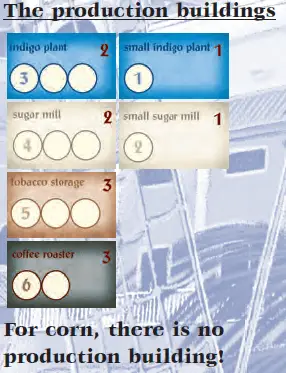

Violet Buildings
There are 17 different violet buildings:
- two each of the 12 small buildings and
- one each of the 5 large buildings.
The special functions of the violet buildings tend to allow players to break the normal game rules.
For example, the owner of an occupied office may sell a kind of goods to the trading house that is already there.
A player is not required to use the special function of an occupied violet building if he does not want to.
Small Buildings
Here are the special functions when you own the different types of small buildings
Small Market
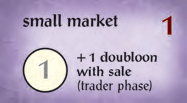
Sell a good in the trader phase and gets an extra doubloon from the bank.
Example: Anna sells a corn and receives 1 doubloon.
Hacienda

On your turn in the settler phase:
- takes a face-up plantation tile, take an additional tile from the face-down stack (the top-most) and place it on an empty space on your island. You may then take your normal turn in the phase.
Note: if you choose to take a face-down tile, you must immediately place it on an empty space on your island. You may not discard it.
If you also own an occupied construction hut, you may not take a quarry instead of the face-down tile. Thus, if a settler owns a hacienda, he may only take one quarry.
Construction Hut
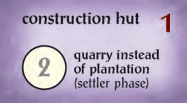
In the settler phase, you can place a quarry on your island instead of one of the face-up plantation tiles.
Note: if the settler owns a construction hut, he may only take one quarry.
Small Warehouse

At the end of the captain phase, in addition to the single goods barrel, you are allowed to store on your windrose, all the barrels of one kind of goods that you choose.
The warehouse protects you from returning goods to the supply. It does not protect you from being required to load the goods onto the cargo ships.
Note: the goods chosen are not actually stored on the small warehouse tile but on the player’s windrose.
Hospice
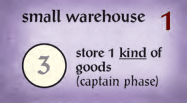
During the settler phase, you place a plantation or quarry tile on your island, you may take a colonist from the colonist supply and place it on this tile.
Note: if the player also owns an occupied hacienda and chooses to take the additional face-down or quarry tile, he does not get a colonist for the extra tile.
If there are no more colonists in the colonist supply, he may take one from the colonist ship. If there are also none there, he goes without.
Office
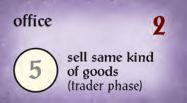
When you sell a good to the trading house in the trader phase, it need not be different than the goods already there. If the trading house is full, you cannot sell a good there!
Example: the trading house already has a barrel of tobacco. Bob owns an occupied office and, on his turn, sells a tobacco to the trading house. Chris owns the other office. On her turn it is occupied, so she too can sell a tobacco to the trading house.
Large Market
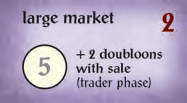
When you sell a good in the trader phase, you get an extra 2 doubloons from the bank.
Note: if a player owns both a small and large market, he takes an extra 3 doubloons when he sells a good to the trading house.
Large Warehouse
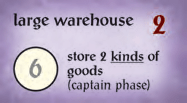
You may store, at the end of the captain phase, in addition to the single goods barrel you are allowed to store on your windrose, all the barrels of two kinds of goods that you choose.
Note: if a player owns both a small and large warehouse, he may store all the barrels of 3 kinds of goods that he chooses.
Factory
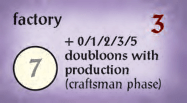
If you produce goods of more than one kind in the craftsman phase, you earn money from the bank:
- for two kinds of goods, you earn 1 doubloon,
- for three kinds of goods, you earn 2 doubloons,
- for four kinds of goods, you earn 3 doubloons, and
- for all five kinds of goods, you earn 5 doubloons.
Example: David owns an occupied factory, 3 occupied corn plantations, 3 occupied sugar plantations, 1 occupied tobacco plantation, and the associated production buildings with the necessary number of colonists. He produces only 2 sugar barrels and 1 tobacco barrel as there is no corn and only 2 sugar barrels in the supply. He earns 1 doubloon from the bank for producing 2 kinds of goods.
University
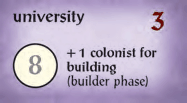
During the builder phase, when you build a building in your city, you may take a colonist from the colonist supply and place it on this tile.
Note: if he builds a production building with more than one circle, you get only one colonist. If there are no more colonists in the colonist supply, you may take one from the colonist ship. If there are also none there, you go without.
Harbor

Each time, during the captain phase, when you load goods on a cargo ship, you earn one extra victory point.
Example: the owner of an occupied harbor (and an occupied wharf) can only load 3 of his 5 tobacco on the “tobacco ship” as those 3 fill it up: he earns 3+1 VP. In his next loading turn, he loads both his 2 sugar on the “sugar ship”: he earns 2+1 VP. In his next loading turn, he uses his wharf to put his remaining 2 tobacco in the supply: he earns 2+1 VP. Thus, in this captain phase he has earned an additional 3 VP with the use of his harbor (and 2 VP extra with his wharf).
Wharf
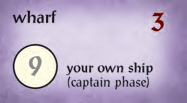
The player must load goods on a cargo ship whenever he can on his turn during the captain phase, except when he chooses to use his wharf and “load” them on his imaginary ship.
The wharf can only be used once per captain phase by its owner, but he may choose when to use it, if at all.
This imaginary ship can take any one good, but it may be of a kind on one of the three cargo ships or the other imaginary wharf ship.
Note: when a player uses his wharf, he must load all the goods barrels of the kind he chooses that he has. He is not required, however, to choose the good he has the most of.
An imaginary wharf ship has the capacity for 11 barrels.
Large Buildings
Guild Hall
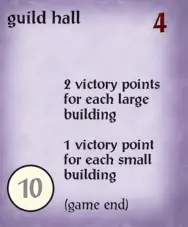
At game end, you gain:
- an additional 1 VP for each small production building (occupied or unoccupied) in your city (= small indigo plant and small sugar mill), and
- an additional 2 VP for each large production building (occupied or unoccupied) in your city (= indigo plant, sugar mill, tobacco storage, and coffee roaster).
Example: at game end, the owner of the occupied guild hall also has a small and large sugar mill, a small indigo plant, and a coffee roaster in his city: he earns an additional 6 VP.
Residence
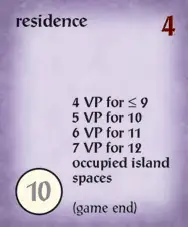
You earn, at game end, additional victory points for the plantations and quarries you have placed on his island, you earn
- 4 VP for up to nine filled island spaces,
- 5 VP for ten filled island spaces or
- 6 VP, for eleven filled island spaces or
- 7 VP, and for all twelve spaces filled
Example: at game end, the owner of the occupied residence has filled 10 of his 12 island spaces with plantations and quarries: he earns an additional 5 VP.
Fortress
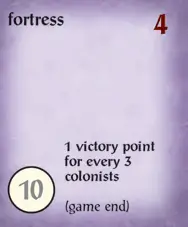
At game end, you gain one additional victory point for every three colonists on your player board.
Example: at game end, the owner of the occupied fortress has a total of 20 colonists on his plantations, quarries, buildings, and in San Juan: he earns an additional 6 VP.
Customs House
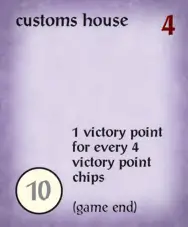
You earn, at game end, one additional victory point for every four victory points acquired during the game.
You should count only your victory point chips (and any extra victory points recorded on paper after the chip supply was exhausted, but before game end).
You do not use victory points earned for your buildings at game end.
Example: at game end, the owner of the occupied customs house has accumulated 23 victory points in VP chips: he earns an additional 5 VP.
City Hall
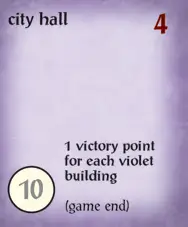
You earn, at game end, one additional victory point for each violet building (occupied or unoccupied) in your city (city hall counts!)
Example: at game end, the owner of the occupied city hall also has: hacienda, harbor, office, construction hut, large warehouse, and residence: he earns an additional 7 VP.


